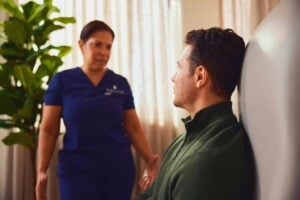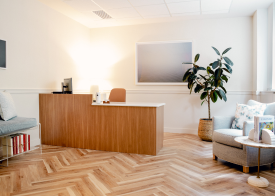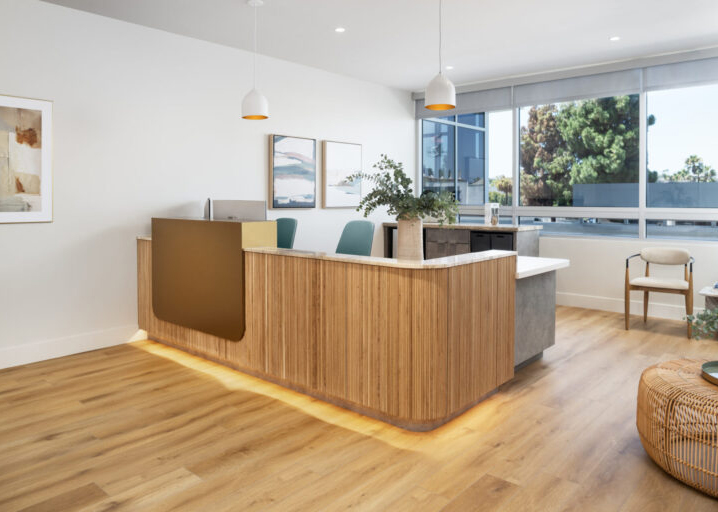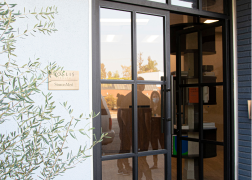When and how were you diagnosed with endometriosis?
Four years ago, when I went in for a routine fertility consultation. An ultrasound revealed I not only had a low ovarian reserve and was not a strong candidate for egg freezing, but that I also had large endometriomas cysts on both of my ovaries.
You had a laparoscopy earlier this year. For those who don’t know, what does that entail, and what was it like?
My surgeon inserted a laparoscope through a small incision in my belly to remove my cysts. Once inside, he found and removed an extensive amount of endometriosis from my ovaries, bladder, and rectum. The surgery itself took a little over five hours. I spent the first week recovering in bed. From there it took another six weeks to fully heal and resume my menstrual cycle.
Tell us a little about life now post-laparoscopy.
There was always a chance that my endometriosis could return post-surgery. At the time, I was comforted by data on the procedure, which indicated that it was unlikely to grow back in the next one to five years, if at all. I was excited to live pain free, or at least with a dramatically reduced level of pain.
I had a feeling something was off about a month post-op when my lower back started spasming, a symptom that had originally been alleviated by the surgery. Within forty days, a new endometrioma had grown on my left ovary, nearly identical in size to the one removed. While unlucky and disappointing, my surgeon did remove an extensive amount of endo without interfering with my already small ovarian reserve, so for that I am grateful.
In pursuit of conceiving, I will start daily Lupron hormone injections for a couple months to suppress my endo ahead of an IVF transfer. We are hopeful and eager for these next steps as our IVF journey started about two years ago. I will assess long-term options like a second more aggressive surgery post giving birth. In the meantime, I am prioritizing my pain management and mental health.
“When I told a doctor I had paralyzing menstrual cramps and was bleeding through my pants twice a month, he advised me to wear dark-colored clothing.”

Without any real cure for endometriosis, what else have you done to mitigate your pain? Have you discovered anything holistic that you’d recommend?
Most mornings I wake with inflammation in my pelvic floor (and pelvic tissue) that causes significant tightness in my lower back and muscle spasms throughout my pelvic region and back. Because your pelvic floor muscles are attached to your hips and pelvic bones, these spasms can change my hip alignment, making getting out of bed an awkward and painful event (think a baby deer learning how to walk). Deep breathing, pelvic stretches, and a hot shower are my go-to aids on those mornings. In addition, I try to stick to an anti-inflammatory diet and avoid caffeine, gluten, and fried foods, which exacerbate my symptoms. Bi-weekly acupuncture helps me relax; I like to bring my headphones so I can listen to a grounding meditation while getting my treatment.Have there been any times you haven’t felt seen or heard by your doctors? What’s the worst medical horror story you can share with us?
Several years ago, I spoke with my (then) GP about what I now know to be common endo symptoms. He insisted I had IBS and sent me to a gastroenterologist. When I told that doctor I had paralyzing menstrual cramps and was bleeding through my pants twice a month, he advised me to wear dark-colored clothing. More recently I had a fertility doctor tell me I had blocked fallopian tubes due to an untreated STI from childhood; when I told him I was not sexually abused as a child, he said I likely did not remember it. While it is possible for STIs to cause fallopian blockages, so can endometriosis, but when I challenged his assumption by bringing up my (diagnosed) endo, he became combative and cruel. A week later, an HSG test—which shows the internal shape of the uterus and any fallopian blockages—confirmed that my tubes were completely clear. I wish my experience was an anomaly, but sadly I’ve heard countless stories of medical gaslighting and abuses of power in the women’s health and fertility spaces. Throughout this process, I have learned to advocate for myself, get second opinions, and only continue with doctors I trust.What do you think is the biggest misconception about endo, and is there anything you wish you could help people understand better?
Endometriosis is not one-size-fits-all and pain is not always cyclical. I’ve had many flare up periods of constant pain outside of my menstrual cycle.“I wish my experience was an anomaly, but sadly I’ve heard countless stories of medical gaslighting and abuses of power in the women’s health and fertility spaces. I have learned to advocate for myself, get second opinions, and only continue with doctors I trust.”

Considering how painful it can be, and that it affects 1 in every 10 women, why do you think endo isn’t discussed more, especially among men?
We need not look further than the Supreme Court’s overturning of Roe v. Wade to understand the degree to which women’s health issues are stigmatized and the patient’s needs and opinions devalued. Only after fertility enters the equation does a disease like endometriosis suddenly become more compelling, but even then, the focus is on enabling us as women to fulfill the societal expectation to make babies—not our right to lead healthy, productive lives independent of procreation. This must change.
If there’s been any silver lining to having it, what would you say it is?
Living with endometriosis has forced me to sit with the unknown. My default thinking is black and white; with endo, I exist in the gray. Each ultrasound could, and usually does, present a curveball. The best laid plans are ever changing. I am getting better with going with the flow and not sweating the small stuff. I am grateful for what I have and the potential the future holds.
What have you learned about endo—and about yourself—along the way, and what would you recommend to women who are quietly suffering?
Advocate for yourself and persist. Really dig into your insurance plan to understand what’s covered and how you can use those services. Research a support group and/or agency. Get to know your period. Conversation breeds education—don’t be afraid to reach out to your network.
What are you looking forward to about being a member of Sollis?
Trying to find the right specialists can feel like a full-time job. Being able to get immediate referrals and expedited appointments with some of the best practitioners in LA makes a profound difference.
Any good words to live by?
My body, my choice.







